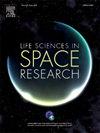Goldfish regenerated scale culture at low temperatures improves osteoblast and osteoclast survival in scales without loss of the osteoblast and osteoclast response to changes in gravity
IF 2.8
3区 生物学
Q2 ASTRONOMY & ASTROPHYSICS
引用次数: 0
Abstract
Biological samples that can be stored for long periods are desirable for experiments in space because of the potential for postponement of space vehicle launches. In this study, we determined whether culturing goldfish scales at lower temperatures increased survival of osteoblasts and osteoclasts in the scales without affecting their biological activities. After one-week storage of regenerated goldfish scales at 4 °C, both alkaline phosphatase (ALP)-positive osteoblasts and tartrate-resistant acid phosphatase (TRAP)-positive multinucleated osteoclasts (active type of osteoclasts) were detectable. Importantly, the multinucleated osteoclasts formed actin rings and expressed cathepsin K, indicating that the osteoclasts had resorptive activity. Additionally, a one-week storage of goldfish scales at 4 °C showed little effect on osteoblastic and osteoclastic activities in the scales. Therefore, after one-week storage at 4 °C, the regenerated scales were treated with vibrational acceleration due to gravity (3 G) for 10 min and then incubated at 15 °C for 6 h. ALP and TRAP activities in the regenerated scales sensitively responded to 3 G hypergravity: compared to unexposed scales, ALP activity significantly increased and TRAP activity significantly decreased in the regenerated scales. Next, the regenerated scales were stored at 4 °C and launched on the space shuttle Atlantis STS-132 (ULF4) to study the effects of vibration (maximum 6.8 G, 2 min) and subsequent hypergravity (maximum 3 G, 8 min 30 s) induced by the launch process. The results showed the vibration and subsequent hypergravity increased significantly ALP activity in the regenerated scales at 4 °C. In addition, our experiment with the Cell Biology Experiment Facility in outer space revealed that osteoblast activity in the regenerated scales decreased in response to microgravity after 6 days-storage of the scale at 4 °C. These findings show that goldfish scales can be stored at 4 °C for around one week, while maintaining the responsiveness of the osteoblast and osteoclast in the scales to changes in gravity.
低温培养金鱼再生鳞片可提高鳞片中成骨细胞和破骨细胞的存活率,而不会丧失成骨细胞和破骨细胞对重力变化的反应
可以长期储存的生物样本对于空间实验来说是可取的,因为有可能推迟空间飞行器的发射。在这项研究中,我们确定了在低温下培养金鱼鳞片是否能提高鳞片中成骨细胞和破骨细胞的存活率,而不影响它们的生物活性。将再生的金鱼鳞片在4℃下保存一周后,可检测到碱性磷酸酶(ALP)阳性的成骨细胞和抗酒石酸酸性磷酸酶(TRAP)阳性的多核破骨细胞(活性型破骨细胞)。重要的是,多核破骨细胞形成肌动蛋白环并表达组织蛋白酶K,表明破骨细胞具有再吸收活性。此外,金鱼鳞片在4°C下储存一周对鳞片的成骨细胞和破骨细胞活性几乎没有影响。因此,在4℃下保存一周后,再生鳞片在重力(3g)振动加速下处理10分钟,然后在15℃下孵养6小时。再生鳞片的ALP和TRAP活性对3g超重力敏感:与未暴露鳞片相比,再生鳞片的ALP活性显著升高,TRAP活性显著降低。接下来,将再生的尺度在4°C下储存,并在亚特兰蒂斯号航天飞机STS-132 (ULF4)上发射,研究发射过程中引起的振动(最大6.8 G, 2 min)和随后的超重力(最大3 G, 8 min 30 s)的影响。结果表明,在4°C时,振动和随后的超重力显著增加了再生鳞片的ALP活性。此外,我们在外太空的细胞生物学实验设备上进行的实验表明,在4°C下保存6天后,再生鳞片中的成骨细胞活性在微重力下有所下降。这些研究结果表明,金鱼鳞片可以在4°C下保存一周左右,同时保持鳞片内成骨细胞和破骨细胞对重力变化的反应性。
本文章由计算机程序翻译,如有差异,请以英文原文为准。
求助全文
约1分钟内获得全文
求助全文
来源期刊

Life Sciences in Space Research
Agricultural and Biological Sciences-Agricultural and Biological Sciences (miscellaneous)
CiteScore
5.30
自引率
8.00%
发文量
69
期刊介绍:
Life Sciences in Space Research publishes high quality original research and review articles in areas previously covered by the Life Sciences section of COSPAR''s other society journal Advances in Space Research.
Life Sciences in Space Research features an editorial team of top scientists in the space radiation field and guarantees a fast turnaround time from submission to editorial decision.
 求助内容:
求助内容: 应助结果提醒方式:
应助结果提醒方式:


